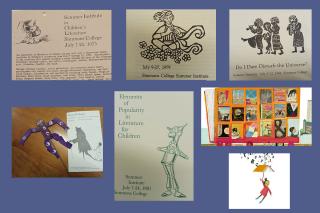This summer, Simmons’ Center for the Study of Children's Literature presents the 2025 Summer Institute in honor of the Center’s 50th birthday. The Institute theme for 2025, “Are We There Yet?” reflects on the Center’s founding mission to promote the academic study of literature for young people and to celebrate “the humanizing potential” of young people’s literature.
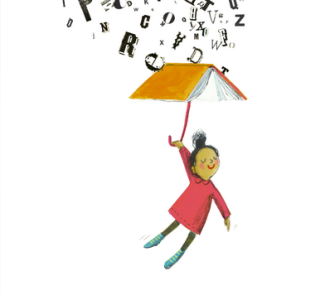
As the website states, “The theme challenges us to lose and find ourselves as we make way for the future and chase (im)possible dreams. Are We There Yet? makes us chuckle in familiarity with our own jiggling impatience for coming home. Authors and illustrators invite us into the pages of a book and beckon us to stay there for a while. As we pause to read or take time to gather together, we find nourishment and renewal.”
In honor of this year’s Summer Children's Literature Institute, we take a look back at the rich history of these events over the last 50 years, which gathered creators, scholars, and readers to mine the brilliant simplicity and compelling complexity of literature published for young people and read by so many others.
A Promising Beginning of a Simmons Tradition: 1970s
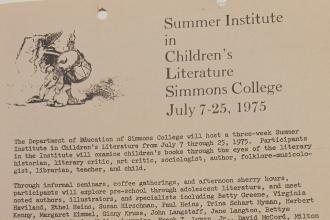
From July 7–25, 1975, Simmons College’s Department of Education hosted a three-week Summer Institute in Children’s Literature. The first event of its kind, participants were welcomed to (per the invitation, located in the Simmons Archives): “examine children’s books through the eyes of the literary historian, literary critic, art critic, sociologist, author, folklore-musicologist, librarian, teacher, and child.”
Per the invitation of Barbara Harrison, then teaching in the Department of Education, the event consisted of “informal seminars, coffee gatherings, and afternoon sherry hours.” The event offered an impressive host of speakers, each with their own designated focus:
- Seminar leader Paul Heins, then-editor of The Horn Book (which offered a critique of contemporary children’s literature) represented “participant as literary critic.”;
- Walter Lorraine, who was then the Director of Children’s Books at Houghton Mifflin was “the art critic”;
- John Langstaff, founder of the Revels in Cambridge, Massachusetts, offered the point of view of “folklore-musicologist”;
- Jane Langton, author of The Diamond in the Window (Harper, 1962) and The Boyhood of Grace Jones (Harper and Row, 1972), offered an authorial viewpoint;
- Ginny Kruse, a teacher and librarian who went on to be director of the Cooperative Children’s Book Center from 1976 to 2002, was “librarian”;
- Virginia Haviland, founder of the Center for Children’s Literature at the Library of Congress in Washington, DC, and internationally-renowned author of the Favorite Fairy Tales series, as literary-historian;
- Bettye Latimer, an expert on children’s books and racism, was the “sociologist”;
- Frank T. Lyman, Jr., a teacher and educational consultant as “teacher”;
- Betty Levin, author and children’s book historian and founder of the Simmons Center for the Study of Children’s Literature; and
- Author, poet, illustrator, and artist Marian Parry
Presaging discussion of eclectic viewpoints, Langton’s pre-seminar reading list included William Faulkner’s As I Lay Dying, Virginia Hamilton’s M.C. Higgins the Great, and Mary Norton’s The Borrowers. Meanwhile, the first Summer Institute showed deference to its Boston roots and offered a literary tour of the city with Paul Heins and his wife, Ethel Heins, another co-founder of the Center.
This auspicious beginning set the stage for a Simmons tradition.
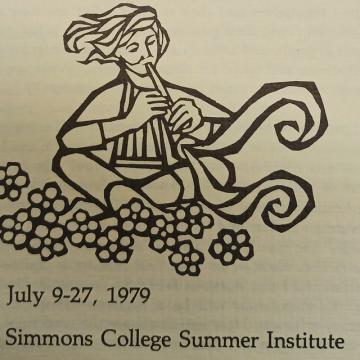
The 1979 Summer Institute was themed “The Child in Literature: Songs of Innocence, Songs of Experience.” The speaker list included Newbery Medal Winners Susan Cooper (The Grey King, 1976), Katherine Paterson (The Bridge to Terabithia, 1978), and Ellen Raskin (The Westing Game, 1979). Though we would not have called it that then, this program attended to the construction of childhood, the child as a literary figure, and the young person as the audience.
As the brochure indicated: “Participants at the Institute will examine the dimensions of childhood experience in a number of selected books for children. The core faculty will address a variety of questions. How do children portrayed in literature come to know themselves and their worlds? What are their conflicts and fears, their passions and dreams? What causes them anguish, and what causes them joy? When are they victorious, and when are they victimized? What are their songs of innocence and their songs of experience?”
Throughout the 1970s, Institute themes revealed contemporary concerns. For example, a panel session with authors Esther Hautzig, Doris Orgel, and Johanna Reiss on “The Child in War” presented the informed perspectives of three authors born outside of the United States (Poland, Austria, and the Netherlands, respectively), their lives disrupted by World War II. Author Robert Cormier was a speaker at every Institute, beginning in the 1970s, until he passed away in 2000. His books, such as The Chocolate War, I am the Cheese, were incisive reflections of contemporary anxiety: the violent enforcement of cultural norms, violence, and government control.
Big Names and Big Questions: 1980s
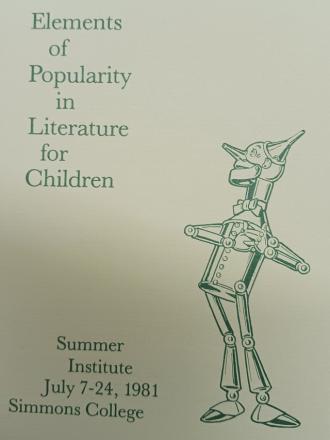
In the 1980s, renowned authors — both critically and commercially — continued to speak at the Institute. Simmons faculty member Nancy Bond, author of A String in the Harp (Newbery Honor Book, 1977), joined the 1981 Institute, “Elements of Popularity in Literature for Children.” The 1981 Institute was co-directed by Harrison and then-Acting Director of Community Programs and faculty member Gregory Maguire '78MA.
Then an author of children’s books, Maguire had yet to make his adult publishing debut with the wildly successful Wicked: The Life and Times of the Wicked Witch of the West. The logo used in all Institute publications for the year was a drawing of the Tin Man from L. Frank Baum’s The Wonderful Wizard of Oz, [drawn by W. W. Denslow, 1900] which could be seen as a foreshadowing of his future imaginative endeavors.
The Institutes’ diverse themes offer evidence of the historical vivacity of literature for young people. In 1983, “Do I Dare Disturb the Universe,” boasted a presentation of The Horn Book Magazine by then-editor Ethel Heins and a “potluck supper at the eighteenth-century home of Jane Langton.”
An Immersive Weekend Institute: 1990s–2019 (and beyond)
Simmons students of the past few decades will be familiar with the Institute’s core team: then-Center Director, the late Susan Bloom (1938–2019), and then-Associate Director Cathryn Mercier, who directed the Institutes starting in 1987. Bloom and Mercier co-created the MFA in Writing for Children. Mercier attended the 1983 Institute as a student and was the administrative assistant to Maguire and Barbara Harrison for the 1985 Institute.
“The typical Institute, in the 1980s, was three weeks long. It was offered for credit, and pretty expensive,” says Mercier, now Professor and Graduate Program Director. “Susan and I wanted to reach a wider audience, but we soon found that our widest audience could not be in Boston for three weeks at a time.”
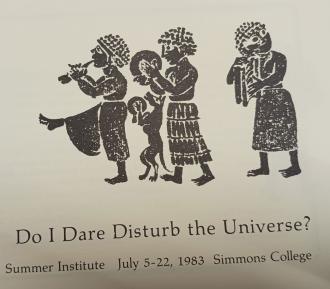
In 1987, the two helmed a revised schedule with “Metamorphosis,” which featured a three-week graduate course and a five-day Institute. “It was still very local. We didn’t have the range of participants we wanted. Not many people from outside of New England, or from the publishing industry. After that, we compressed the Institute into one weekend.” The Symposium course continues to run for three weeks and culminates in a one-weekend Institute, a non-credit event with a distinct registration structure. That evolution has seen the Institute through the last three and a half decades.
“The Institute weekend allows for a concentrated experience, and expands the opportunities for folks to come from further away,” says Mercier. “In the graduate seminar, the students engage with the work of the Institute speakers, then gather on campus as a whole at the Institute.” Symposium students take an active role during the Institute as they introduce the speakers and often become ambassadors for visitors at the event.
The shift to a condensed weekend immersion also supported Mercier and Bloom’s goal of attracting a more diverse range of speakers. “We have an obligation to bring in authors and illustrators that reflect the actual work in the field,” says Mercier. “We committed to early career authors and illustrators and reached out to include diverse creators and publishers.”
In 1991, “Masquerade” promised to address elements of disguise, deception, and the “changing faces of adolescents on the voyage to self-discovery.” Participants received a mask included in their Institute folders. That year, the Symposium was taught by Roger Sutton, then-editor of the Horn Book, who had students cast plaster masks of their faces and don them at some point during the Institute. At the dawn of the new millennium in 2001, “Brave New Worlds” posed the question, “How will children’s and YA [young adult] literature reflect the worlds in which we live? How will they change our world?”
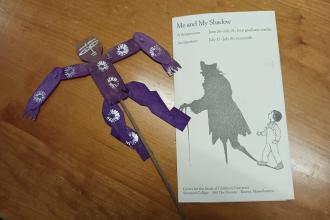
Children’s Literature has changed over the years, both as an industry and a field of academic study.
“When the program started, there was no academic field for Children’s Literature. Barbara Harrison envisioned the first program to take children’s literature as a serious subject worthy of graduate study,” notes Mercier. “The Institutes combine the celebration of creators in the field with academic study. Though the work of the Symposium became more differentiated from the Institute, we never wanted to divorce them, the content is so connected. The Institute offers a unique, immersive integration of the academic and the humanities.”
Mercier and Bloom took a hands-on approach to all elements of the Institute. From the food and decor to the closing remarks, there was always a cohesive theme.
“For ‘Metamorphosis,’ our first Institute together and very early in the work partnership that became a deep, lifelong friendship, Susan asked local attendees to bring in vegetables from their gardens,” Mercier recalls. “I was in Susan’s kitchen, writing our final talk, while she was cutting up zucchini and tomatoes for gazpacho to serve at the Institute’s closing reception.”
That same institute included a display provided by The Butterfly Place in Westford, MA, that exhibited the five stages of a chrysalis as it changed over the course of the five-day event. “On the last day, they came with hundreds of butterflies to release into the air.” Themed food continued; in 2022, Gregory Maguire brought sugar cookies made by his daughter to commemorate his novel, Cress Watercress.
Mercier, current director of the Center and the graduate degree programs, said, “Susan’s reputation as a critic and as a creative spirit fortified Barbara’s original vision and together we enhanced the University’s status as a leader in children’s literature.”
After Bloom’s retirement in 2005, Simmons established the Susan P. Bloom fund to support the Center’s Institutes. “By far the most memorable tribute to Susan was at the 2013 ‘Love Letters’ Institute, where Lois Lowry's talk was, indeed, a love letter to Susan.” At the 2019 Institute, “Make Way,” her colleagues and students had the opportunity to honor Bloom’s memory.
‘Are We There Yet?’: A New Era, New Leaders

“Each Institute has its own tonality,” notes Mercier. “It isn’t just the body of speakers, but the audience and how they celebrate children’s and young adult literature and collectively create community across professions.”
Organizers also infuse the events with new flavor. This year, Children’s Literature alumna Lauren Rizzuto ’11MA returns to teaching at Simmons as the 2025 Carol S. Kline Visiting Lecturer for the Symposium course and Assistant Teaching Professor Shelley Isaacson co-direct the Institute, as she did in 2022.
“What our program does best is a complete immersion with people as passionate about the field of children’s literature as you are. Alumnae/i come back every two years because they want that immersion. They say, ‘I yearn for the kinds of conversations I had when I was a student here and the Institute gives me that uplift.’”
In 2025, “Are We There Yet?” is a meditation on where we’ve been and where we’re heading. “It’s a time to celebrate and reflect,” says Mercier. “Restoration is important, and this is a way to feed yourself as a teacher, librarian, editor, writer, critic with other people also passionate about what you do. That is the gift we bring to each other in every Institute, especially one celebrating our 50th birthday!”
Given the Center’s 50th birthday, Mercier is eager to celebrate its roots; Barbara Harrison is scheduled to attend the Institute.
“I told her to come and enjoy the parade of people who will march before her, to see the continued passion that still characterizes Institutes she began in 1975 and to see what her vision for a graduate program has yielded through generations of students,” says Mercier. “How many of us get to see the extent of our influence? I hope that she will get to see how many lives she has touched through establishing graduate study in children’s literature, by having specific conversations with alumnae/i, and by seeing the work that they do.”
The project of delving deep into the heart of children’s literature at Simmons is still underway, growing more vibrant and essential by the year.

